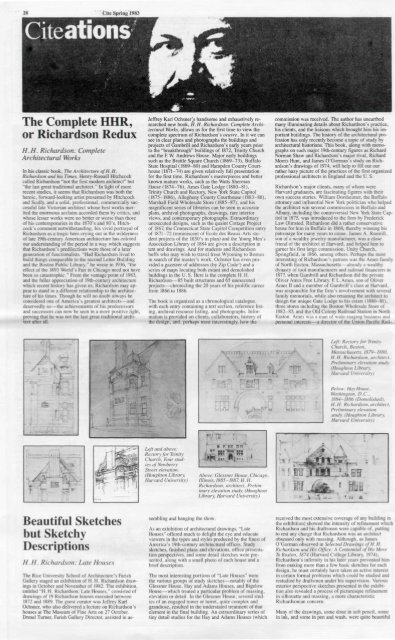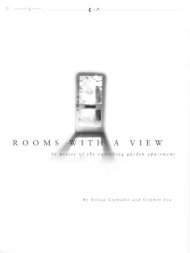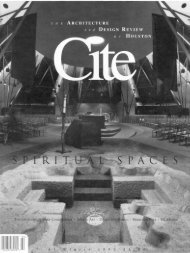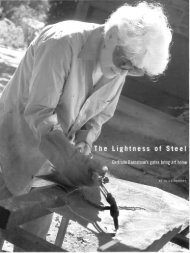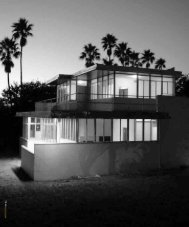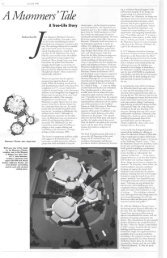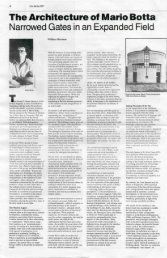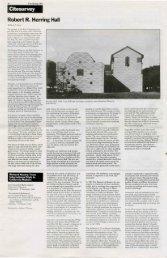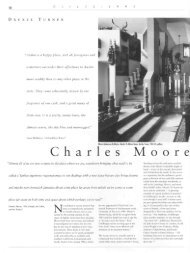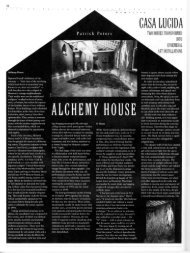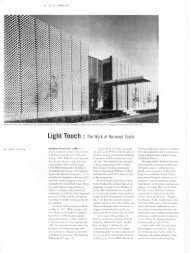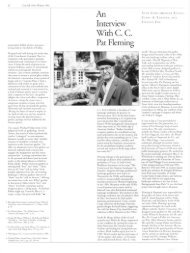Citeations - Cite Magazine
Citeations - Cite Magazine
Citeations - Cite Magazine
Create successful ePaper yourself
Turn your PDF publications into a flip-book with our unique Google optimized e-Paper software.
<strong>Cite</strong> Spring 1983The Complete HHR,or Richardson ReduxH.H. Richardson: CompleteArchitectural WorksIn his classic book. The Architecture ofH. H.Richardson and his Times, Henry-Russell Hitchcockcalled Richardson "not the first modern architect" but"the last great traditional architect." In light of morerecent studies, it seems that Richardson was both theheroic, forward-looking artist presented by Hitchcockand Scully, and a solid, professional, commercially successfullate Victorian architect whose best works meritedthe enormous acclaim accorded them by critics, andwhose lesser works were no better or worse than thoseof his contemporaries in the 1870's and 80's. Hitchcock'scomment notwithstanding, his vivid portrayal ofRichardson as a tragic hero crying out in the wildernessof late 19th-century American architecture has coloredour understanding of the period in a way which suggeststhat Richardson's predilections were those of a latergeneration of functionalists. "Had Richardson lived tobuild things comparable to the second Leiter Buildingand the Boston Public Library," he wrote in 1936, "theeffect of the 1893 World's Fair in Chicago need not havebeen so catastrophic." From the vantage point of 1983,and the fuller appreciation of 19th-century architecturewhich recent history has given us, Richardson may appearto stand in a different relationship to the architectureof his times. Though he will no doubt always beconsidered one of America's greatest architects—anddeservedly so—the achievements of his predecessorsand successors can now be seen in a more positive light,proving that he was not the last great traditional architectafter all.Jeffrey Karl Ochsner)s handsome and exhaustively researchednew book, H.H. Richardson: Complete ArchitecturalWorks, allows us for the first time to view thecomplete spectrum of Richardson's oeuvre. In it we cansee in clear plans and photographs the buildings andprojects of Gambrill and Richardson's early years priorto the "breakthrough" buildings of 1872, Trinity Churchand the F. W. Andrews House. Major early buildingssuch as the Brattle Square Church (1869-73), BuffaloState Hospital (1869-80) and Hampden County Courthouse(1871-74) are given relatively full presentationfor the first time. Richardson's masterpieces and betterknown mature works, such as the Watts ShermanHouse (1874-76), Ames Gate Lodge (1880-81),Trinity Church and Rectory, New York State Capitol(1875-1886), Allegheny County Courthouse (1883-88),Marshall Field Wholesale Store (1885-87), and hismagnificent series of libraries can be seen in accurateplans, archival photographs, drawings, rare interiorviews, and contemporary photographs. Extraordinaryunexecuted designs, such as the quaint Cottage Projectof 1867. the Connecticut State Capitol Competition entryof 1871-72 (reminiscent of Ecole des Beaux-Arts studentprojects of the 1850's in plan) and the Young Men'sAssociation Library of 1884 are given a description intext and drawings. And for students and Richardsonbuffs who may wish to travel from Wyoming to Bostonin search of the master's work, Ochsner has even provideda gazeteer of addresses (by Zip Code!) and aseries of maps locating both extant and demolishedbuildings in the U.S. Here is the complete H.H.Richardson—85 built structures and 65 unexecutedprojects—chronicling the 20 years of his prolific careerfrom 1866 to 1886.The book is organized as a chronological catalogue,with each entry containing a text section, reference listing,archival resource listing, and photographs. Informationis provided on clients, collaborators, history ofthe design, and, perhaps most interestingly, how thecommission was received. The author has unearthedmany illuminating details about Richardson's practice,his clients, and the liaisons which brought him his importantbuildings. The history of the architectural professionhas only recently become a topic of study byarchitectural historians. This book, along with monographson such major 19th-century figures as RichardNorman Shaw and Richardson's major rival. RichardMorris Hunt, and James O'Gorman's study on Richardson'sdrawings of 1974, will help to fill out ourrather hazy picture of the practices of the first organizedprofessional architects in England and the U.S.Richardson's major clients, many of whom wereHarvard graduates, are fascinating figures with theirown success stories. William Dorsheimer, the Buffaloattorney and influential New York politician who helpedthe architect win several commissions in Buffalo andAlbany, including the controversial New York State Capitolin 1875. was introduced to the firm by FrederickLaw Olmsted. Richardson did a rather conservativehouse for him in Buffalo in 1868, thereby winning hispatronage for many years to come. James A. Rumrill,son of a wealthy jewelry manufacturer, was a closefriend of the architect at Harvard, and helped him togamer his first large commission. Unity Church,Springfield, in 1866, among others. Perhaps the mostinteresting of Richardson's patrons was the Ames familyof North Easton, Massachusetts—already a wealthydynasty of tool manufacturers and railroad financiers in1877. when Gambrill and Richardson did the privateOliver Ames Free Library. F. L.Ames, son of OliverAmes II and a member of Gambrill's class at Harvard,was responsible for the firm's involvement with severalfamily memorials, while also retaining the architect todesign the unique Gate Lodge to his estate (1880-81),three stores including the Boston Wholesale Store of1882-83, and the Old Colony Railroad Station in NorthEaston. Ames was a man of wide-ranging business andpersonal interests—a director of the Union Pacific Rail-'. .•Left: Rectory for TrinityChurch, Boston,Massachusetts, J879- 1880.H.H. Richardson, architect.Preliminary elevation study.(Houghton Library,Harvard University)1Below: Hay House,Washington. D.C..1884-1886 (Demolished),H.H. Richardson, architect.Preliminary ele vat ionstudy. (Houghton Library,Harvard University)^*->Left and above:Rectory for TrinityChurch, Four studiesof NewberryStreet elevation.(Houghton Library.Harvard University)Above: Glessner House. ChicagoIllinois, (885-1887. H.H.Richardson, architect. Preliminaryelevation study. (HoughtonLibrary. Harvard University)— Jt't, • •• j i t . / m>• X - i ABeautiful Sketchesbut SketchyDescriptionsH. H. Richardson: Late HousesThe Rice University School of Architecture's FarishGallery staged an exhibition of H. H. Richardson drawingsin October and November of 1982. The exhibition,entitled "H. H. Richardson: Late Houses," consisted ofdrawings of 19 Richardson houses executed between1872 and 1889. The guest curator was Jeffrey KarlOchsner, who also delivered a lecture on Richardson'shouses at The Museum of Fine Arts on 27 October.Drexel Turner, Farish Gallery Director, assisted in assemblingand hanging the show.As an exhibition of architectural drawings, "LateHouses" offered much to delight the eye and educateviewers in the types and styles produced by the finest ofAmerica's 19th-century architectural offices. Studysketches, finished plans and elevations, office presentationperspectives, and some detail sketches were presented,along with a small photo of each house and abrief description.The most interesting portions of "Late Houses" werethe various groups of study sketches—notably of theGlessner House. Hay and Adams Houses, and BigelowHouse—which treated a particular problem of massing,elevation or detail. In the Glessner House, several studiesof an engaged tower or turret, quite complex andgrandiose, resulted in the understated treatment of thatelement in the final building. An extraordinary series oftiny detail studies for the Hay and Adams Houses (whichreceived the most extensive coverage of any building inthe exhibition) showed the intensity of refinement whichRichardson and his draftsmen were capable of. puttingto rest any charge that Richardson was an architectobsessed only with massing. Although, as JamesO'Gorman observed in Selected Drawings of H.H.Richardson and His Office: A Centennial of His MoveTo Boston, 1874 (Harvard College Library, 1974),Richardson's infirmity in his later years prevented himfrom making more than a few basic sketches for eachdesign, he must certainly have taken an active interestin certain formal problems which could be studied andrestudied by draftsmen under his supervision. Variousexterior perspective sketches presented in the exhibitionalso revealed a process of picturesque refinementin silhouette and massing, a more characteristicRichardsonian concern.Many of the drawings, some done in soft pencil, somein ink. and some in pen and wash, were quite beautiful
<strong>Cite</strong> Spring 1983 29road which his father had helped to form, with investmentsin manufacturing and real estate. He was the kindof confident, almost princely patron well suited toRichardson's artistic temperment, who typified the sortof philanthropic noblesse oblige found in men likeAndrew Carnegie later in the century. Significantly,Richardson's most abstractly expressive Ames familycommissions were memorials—the Free Library, OakcsAmes Town Hall, and the powerful Ames Monument inWyoming. Hitchcock considered the latter to be the finestmemorial in America, an extraordinary vindicationfor the scandal which followed the Ames brothers'financial dealings over the Union Pacific Railroad.Ochsner's catalogue entries, while providing client descriptionsand building histories of interest to historians,also contain building descriptions and data on the currentcondition of the structure. While this makes ratherdull reading (and, to be fair, this is not a book for lightamusement but a reference) it serves an important preservationpurpose. Here the author deserves commendationfor the tremendous effort put forth in visiting andsurveying all of the Richardson buildings still standingin the U.S. during an eight-year period. This book andthe recent Frank Lloyd Wright catalogue by Storrer arethe only complete historic surveys made of the work ofmajor American architects, and more will be needed ifvaluable examples of American architecture arc not tobe lost through ignorance. Like most historic surveys,this document also gives an assessment of the "significance"of each structure. Because the author is ableto bring his considerable knowledge of the opinions ofRichardson scholars to bear on this problem, whatresults is a more authoritative statement of value thancan be found in most local surveys.The book is thus something of a hybrid: part art historicalcatalogue, part reference, part survey, part gazeteerand part picture book. Luckily for architects of a lesshistorical bent who like Richardson's work, the authorand book designers have contrived to give the illustrationssome prominence and to throw in as many as possible.Most of the photos arc of excellent quality, and asubstantial number of drawings have been included,though not always enough to fully describe a project.One wonders why plans were omitted for some majorbuildings, such as the New York State Capitol andAlbany City Hall, and why buildings like Sever Hall andthe Stoughton House deserved relatively few photographs(none of which showed views of the rear).Still, these omissions do not take away from the valueof the book as a visual document, and most of thosewho will spend the $50 required to own a copy will doso because of the richness and relative completeness ofthe visual information. What emerges from a carefulperusal of the 386 illustrations is. I believe, a differentHenry Hobson Richardson from the one most of us cameto know through the standard histories of 19th and20th-century architecture. Just as we began to see a lessprotean Frank Lloyd Wright as more of his early careerwas unveiled, Richardson too can be seen as an architectwho absorbed and transformed the influences of hisepoch gradually. And we can now more readily comparehis work to the standard commercial, religious, and domesticarchitecture of the period. Richard Morris Hunt,Richardson's less talented but equally successful contemporary,produced a body of work not dissimilar inprofile and type to that of his Boston rival—buildingsthought at the time to be distinguished in relation to themilieu, but even then judged to be far inferior to Richardson's.Both architects struggled with the exigenciesof new building technologies, programs, and a changingclientele—some clients with vision, others with ratherunsophisticated tastes. Hunt had fewer artistic successesthan Richardson, but achieved some innovative andviable solutions to the architectural problems of histime. In Richardson's lesser works and those in whichhis individual maniera is not prominent, one can seethe same hesitancy and conservatism found in mostbuildings of this period of rapid economic growth andcultural uncertainty.The reasons for Richardson's greatness will no doubtalso be reinforced by the documentation of his total output.Many of his less prominent buildings—the housesof his middle and late period in particular—show aspectsof his compositional genius more readily appreciatedin his public works, a fact noted by Ochsner andby Richardson's first biographer, Mariana Griswold VanRensselaer. Rare views of well-known buildings willallow us to study massing and detailing more fully bygiving a more complete picture. In short, Ochsner'sbook provides the visual basis for a genuinely balancedassessment of the architect's career, one more nearlyapproximating that which his contemporaries couldprovide. Montgomery Schuyler, who saw many ofRichardson's buildings shortly after completion, gavewhat is still the best characterization of Richardson'sparticular compositional genius when he wrote:Now the great and merited success of Richardson was aspersonal and incommunicable as any artistic success canbe. It was due to his faculty of reducing a complicatedproblem to its simplest and most forcible expression.More specifically, it was due to his faculty for seizingsome feature of his building, developing it into predominanceand skillfully subordinating the rest of his compositionto it, until this feature became the building. Itwas his power of disposing masses, his insistence uponlargeness and simplicity, his impatience of niggling, hisstraightforward and virile handling of his tasks, thatmade his successes brilliant, and even his failures interesting.Very much of alt this is a matter of temperament,and Richardson's best buildings were the express imagesof that impetuous and exuberant personability thatall who knew him remember.Mark Hewitt/*u,• t m %if Vr ._ ^rrr. w iirrn i' ' I 1•_u-Above: Project: Ames House, Boston, Massachusetts, 1880.H.H. Richardson, architect. Perspective of front elevation.(Houghton Library, Harvard University)Above and right: Glessner House,Three studies of 18th Street elevation.(Houghton Library, Harvard University)in themselves. Of the drawing techniques used byRichardson and the draftsmen, the less formal softpenciland wash studies allowed a richer and more vitalpresentation of the robust modeling of wall surfaces andmasses which are Richardsonian trademarks. But theexhibition showed that more conventional formal presentationdrawings were also made in colored inkson heavy paper. Richardson was known to dislike gaudycolor-wash renderings of the academic Beaux-Arts typehe had known in Paris as a student. O'Gorman, in his1974 catalogue, asserts that Richardson's preferredpresentation drawing was a brown-ink line drawingdone on heavy paper. The Farish Gallery show makes itclear, however, that a number of styles were employedfor different purposes, perhaps owing to what a clientexpected and what a particular draftsman could execute.Although the problems of attribution for Richardson'soffice drawings are considerable, as O'Gorman's catalogueshows, one wished that, along with the title ofindividual drawings, the Farish Gallery exhibition hadincluded some explanation of who made each drawing(especially if there was reason to suspect that a sketchwas from Richardson's own hand), at what point in thedesign process it was made, why it was made, and moreprecisely what it showed.There were other problems arising from the arrangementof the exhibition. Since a complete photographic anddrawing description was not provided for any of thehouses, it was not only difficult to correlate some of thedrawings with the finished buildings, it was also impossibleto glean a complete impression of the houses'interiors and exteriors. Was the exhibition meant to showRichardson's late domestic architecture, much of itunfamiliar to most of us, in its best light as building?If so, one must question the method and thoroughnessof its presentation. Was the exhibition intended as arecord of Richardson design process and a presentationof architectural drawings as artifacts? "Late Houses"left one wanting more information in a slightly morecoherent format.The show did, however, bring to the general public afascinating series of drawings from an exciting period inAmerican architecture. A few of the Richardson houses,like the Sard House, were not well represented. But farand away most of Jeffrey Ochsner's choices wereexcellent—many drawings from the Houghton Library(not shown in the O'Gorman catalogue) were on view atFarish Gallery, and the series of drawings of the F. WAndrews House were shown for the first time as a resultof Ochsner's research and the courtesy of the Andrewsfamily. A catalogue with more supplemental informationand more extensive analysis would take care of the questionsraised by this stimulating exhibition.Mark Hewitt
30 <strong>Cite</strong> Spring 1983Malinda Beeman'sCairo on the Bayou:Ancient Evenings inSpace CityThere are those who come to Houston to create, capture,feel its energy. Some witness it from afar, like AdaLouise Huxtable, the architectural critic from New York,who declared Houston "an anchor to time and placewhere neither is defined. All those values that accruethroughout centuries of civilization—identity, intimacy.scale, complexity, style—are simply created out ofwhole cloth, or whole prairie" substituting fantasy forhistory. To Huxtable Houston has the "kind of vitalitythat is the distinguishing mark of a great city in anyage."Artist Malinda Beeman sees the same vitality in thebuilt environment in Houston, and for eight years shehas been capturing it in a series of sometimes gentle,sometimes startling images."What got me interested in the architecture of Houstonwas that I came from southern California," saysBeeman. "Some of the first things that excited mewere the older Art Ddco buildings—the gas stationrestaurant-theater facades 1 had never paid attention toin L. A.—like the Alabama Theater, the Tower Theaterand Captain John's Restaurant. They are such unique,beautiful buildings. There is a magnificent theatricalquality to them. They have character."Houston's vitality becomes an integral part of Beeman'sart. She says that the creative energy the Art Decobuildings made her/
From Werkstatteto Our State:Josef HoffmannDesign Classicsin Fort WorthLike so many turn of the century designers, JosefHoffmann, until recently, has been the victim of a typeof criticism that tended to promote one particularaesthetic by demeaning or, even worse, ignoring an essentialbody of work. Now nearly 80 years after thefounding of his Wiener Werkstatte (Vienna Workshop),Hoffmann's name has been resurrected. Hoffmann's designsfor buildings, furniture and domestic items of allsorts are once again the subject of intense interest notonly on the part of critics, historians and connoisseurs,but perhaps more importantly by the present generationof designers.Far away ham fin de siecle Vienna, the work of JosefHoffman was recently the subject of an exhibitioncalled "Josef Hoffmann, Design Classics" held at TheFort Wotlh Art Museum between 17 November 1982 and9 January 1983. The show was organized by the museum'sdirector. David Ryan, with the assistance ofDavid Gebhard, who wrote the excellent cataloguewhich accompanied the show.It is still difficult to attempt an evaluation of Hoffmannindependent of the complexly intertwined histories of1n•31the Vienna Secession (of which he was a leading figure),the English Arts and Crafts movement and theAmerican Craftsman movement. Yet walking into TheFort Worth Art Museum and turning to the exhibition,one was impressed by the objects themselves apart fromquestions of their historical significance. The Hoffmanndesigns—which included dozens of wood chairs, upholsteredsettees, lamps, cigarette cases and silverware—were displayed in a naturally illuminated gallery aspristine objects crafted with intelligence and skill.Even after so many years, the air of experimentationwas still fresh.Hoffmann's sturdy, straight-backed chairs were contrastedwith more delicate furniture ensembles, someappearing too fragile for sitting. And yet these pieceshad in common the essential Hoffmann traits; invention,material integrity and craftmanship.Hoffmann transformed his simple chairs by cutting,bending or laminating the wood framing elements,making the joining of pieces integral to the design.The wood, often beech, was rarely left unfinished butpainted, enameled or lacquered. While painting andlacquering may seem at odds with expressing the natureof the materia], they protected the furniture.Other pieces appeared to have been stained black orbrown. On one stained desk, the wood grain was subtlydrawn out with while paint. Upholstered furniturewas crafted with equal precision. On the underside ofone upholstered armchair, copper springs were revealed.Though the springs were not intended to be viewed,they were Hoffmann's way of insuring durability, suggestingthat no matter how experimental the piece orhow often produced, it was meant to stand up to timeand use.Other furniture pieces included armoires, writing tables,stools and tables, all treated with the same degree of eleganceand restraint as the chairs and the upholstered<strong>Cite</strong> Spring 1983 31seating. The exhibition concluded with the smaller itemsof furnishing. These were silver tureens, silver placesettings, a cigarette box of ebony and inlaid mother-ofpearl,gridded metal waste baskets, lamps and pocketbooks. Like the chairs, settees and tables, these furnishingsrevealed Hoffmann's deep love and respect forthe materials.The Fort Worth exhibition concerned itself mostly withHoffmann's work of the period between 1900 and 1910,although he produced work until his death in 1956.Many of these items have not been seen for decades andone wonders just how much was lost during Hoffmann'speriod of critical rejection. This is true not only ofHoffmann, but of Otto Wagner, Otto Prutscher, in factall the designers of the Vienna Secession. Oddly missingfrom the exhibition were several of Hoffmann's designsthat have remained in production all these years,in particular the bentwood "Prague" chair, made todayin the original mold and distributed in this country byStendig. However, the exhibition showed Hoffmann tohave been an extraordinarily thoughtful designer, anexperimenter, an inventor. Dismissing him as an eccentricdecorator is clearly wrong.Obviously much of the interest in his work today hasarisen because architects are once again turning to furnituredesign and the design of objects. This raises anintriguing question. Wire Hoffmann's works genuinelyvital to the development of art and architecture? Or doestheir revival merely reflect the current interest in anybody of artifacts that did not originate in a moral andaesthetic sphere that would have conformed to the puriststrictures of the Neue Sachlichkeit'.' As Gebhard demonstratesin his catalogue essay, designers often are judgednot on the basis of their actual products, but accepted orrejected on the basis of how well a particular piece fitsinto current philosophies and styles.William F. Stern1JI v • rjilChair, 1906. Josef Hoffmann, designer. (The FortWorth An Museum)Dreams and Schemes:ArchitecturalPermutations of theContemporary ArtsMuseumThroughout most of last fall Houston's ContemporaryArts Museum featured a major architectural exhibitionbased on the theme of its existing building and whathypothetically might become of it and its immediate surroundings.Twenty Houston architects were invited byCAM director Linda Cathcart and curator Marti Mayo tosubmit proposals "both possible and visionary... for theexpansion, renovation, rebuilding or conversion of theexisting museum structure on the present site." Eighteenwidely disparate entries in the form of architecturaldrawings and/or, models were received and exhibitedunder the title "Dreams and Schemes, Visions andRevisions for the Contemporary Arts Museum."Firms and individuals participating ostensibly representeda broad spectrum of Houston's design professionals,ranging from large commercial firms throughsmaller practices of old and new repute to groups ofyoung designers and academics of a more theoreticaland conceptual bent. Approaches or arguments frequentlyissued from surprising quarters, however. Theexhibitors were Arquitect6nica Texas; Howard Barnstone;Anthony E. Frederick; Ian Glennie; Robert E. Griffin inassociation with Randy Gay, John Perry and Bruce C.Webb; Alan E. Hirschfield; William R. Jenkins; ThomasM. Lonnecker, Peter C. Papademetriou and Peter D.Waldman; Morris*Aubry Architects (Ed Brudnicki andJim Postell); Richard Keating of Skidmore, Owings andMerrill, Houston; William F. Stem, Herman Dyal, Jr.,Drexei Turner and Gregory Warwick; Taft Architects;Charles Tapley Associates; 3D/International; AndersonTodd; Urban Architecture (Hossein Oskouie, Rick delMonte and Lucho Gonzales); Marvin Watson, Jr.;and Ziegler Cooper in association with Stephen M.Art Precinct, Alan E. Hirschfield, architect withChris Petrash. (Photo by Rick Gardner.Contemporary Arts Museum)Starensier.Given the CAM's existing building, a bi-level, shinymetal parallelogram by Gunnar Birkerts and Associates(1972). two-thirds of the entrants responded predictablywith a building set within the bounds of the CAM'sproperty lines. Three of the six non-conformingschemes exceeded the site limits or broadened the interpretationof the context under consideration. CharlesTapley Associates took an urban design approach andreworked the entire museum area, with special attentionto rerouting existing transportation systems and connectingto future ones. Alan Hirschfield formed an artprecinct by linking all of the existing cultural institutionswith a thick wall full of art and artists surrounding amajor public plaza.The other three extra-territorial responses were not somuch built solutions as polemical or conceptual statements.The Stem/Dyal/Turner/Warwick submissionignored the existing museum altogether and offered economicjustification for relating the CAM to a new,downtown, high-rise development only generically adumbrated.Taft chose to make a didactic and criticalpoint with their cautionary "Allegorical Cartoon aboutHouston," showing existing buildings growing progressivelyupward as mindless extrusions which eventuallyself-destruct. The third non-building submission. RobertGriffin's "Fond Metaphors." seemed to be solely aboutthe rejection of abstraction, for it consisted of eight toylikemodels of museum-shaped parallelograms dressedupas unbuilding-like objects, e.g.: an iron or a piece ofSwiss cheese.Though degrees of realism varied from highly practicalto conceptual, if not visionary, almost all of the builtsolutions transformed or obscured the existing buildingso as to radically alter, or contrast with, its appearance.Only Marvin Watson showed such deference to the existingvolume as to leave it untouched and dominant.Ian Glennie retained Birkerts's abstract block, but multipliedand telescoped il upward into a metallic ziggurat,a symbolic diagram of his program for building up themuseum's collection.Apparently the abstract scalelessness, blank, inarticulateelevations and obscure entry of the existing building areno longer acceptable, for the remaining 10 buildableModel, Of Gardens, Galleries and Grottos, Lonnecker+ Papadentetriou and Peter D. Waldman, architects.(Photo by Peter C. Papademetriou, ContemporaryArts Museum)solutions sought to remedy some or all of these faults.Sometimes though, as in Arquitectonica's proposal, theBirkerts building was surrounded and displayed withinthe new development as if the old were a period piece ofabstract sculpture.All of the buildings proposed were at least somewhatmore recognizable as buildings than the original, objectsof use and habitation as well as geometry. Many celebratedand made unequivocal the act of entry, whileadding exhibition or activity spaces that were eitherexternal or exposed through transparency. Some exhibitorsused familiar elements in such unexpected andintriguing ways as to impel the viewer into the museumby sheer force of curiosity. "Of Gardens, Galleriesand Grottoes" by Lonnecker + Papademetriou andPeter Waldman engulfed the existing building in anextraordinary new envelope which both concealed andrevealed its contents with glimpses of promised experientialdelights inside and out.High-rise forms were posited by three exhibitors, foretellingan increasingly dense and "urban" developmentof the museum area. Howard Barnstone's "Muse" apartmenttower piled atop the expanded existing museum22 floors of drive-up duplexes for those auto-crazed,wealthy Houstonians who cannot bear to be partedfrom their cars.Only three entrants displayed what might be calledrealism as their primary determinant. Among them,Anderson Todd's solution was notable for its unity.Though Rick Keating of SOM used a similar structuralidea of spanning the existing volume with great trusses,the result was not a whole, but two built objects coexistinginterestingly, but uncomfortably, on the site.An overview of "Dreams and Schemes" demonstratesthe extreme difficulty of adding to so totally selfcontainedand geometrically pure an object as Birkerts'sCAM. Even the combined architectural efforts of thesemany talented individuals yielded few truly desirableprospects. A more foresighted, less compulsivelyabstract and exclusionary approach to the design offuture architecture would better serve Houston's longrange interests.Lynn Bensel-Hewitt
Evans-Monical Cev-ens, man-i-kel) n. 1. ashowcase of classic contemporary home furnishings,gifts, and imaginative decorativeaccessories. 2. a complete design service forcommercial and residential clientele. 3. acompetitive source for office systems andcontract furniture.Where being a goodneighbor is justas important as beinga good company.iTl EVANS-MONICAL2750 Kirby Drive, Houston 77098, (713) 528-2075Open 9 AM — 6 PM, Monday through SaturdayRice Design AllianceMembership ApplicationMembership Benefits(Jul*D Home Adffctsi', ,i ^ T f e l e p h o i i e^•Check preferred milting iddrc&tl>4lCZipHUMncvj AddHDIf 1TelephoneOecuptuon Membership Cmepoo Anvum EntlinnJAre** of Specific InierciiiVHuntecr ImertttsChecks should be sent to the Rice Design AllianceP.O. Box 1892, Houston,Texas 77251Individual Membership $30• Reduced price for all RDA programs• A discount on selected titles from Books, Inc., and the Brazos Bookstore• Invitations to "members only" events related to programs• Participation in the annual membership meeting and event• Receipt of the RDA Publication, CITEStudent Membership $15• AH of the above benefitsSponsor Membership $125• All of the benefits accorded to Individual Members• The option to receive two courtesy tickets to selected RDA programs withreservations in advancePatron Membership $250• All of the benefits accorded to Individual Members• The option to receive four courtesy tickets to selected RDA programs withreservations in advanceSustaining Membership $500• All of the benefits accorded Patron membersCorporate Membership $1,000• All of the benefits accorded Patron membersRDA Rice Design AllianceWilliam Marsh Rice UniversityRO. Box 1892Houston. Texas 77251U.S. Postage PaidNon-profit Org.Permit No. 7549Houston, Texas


